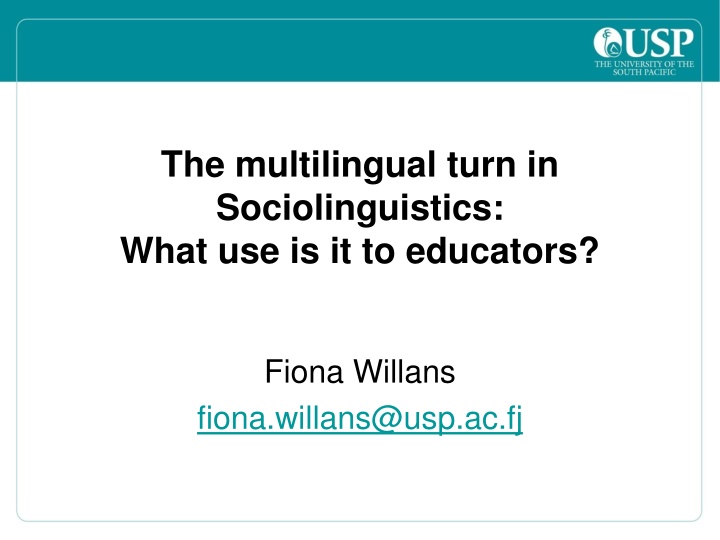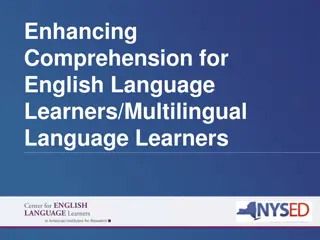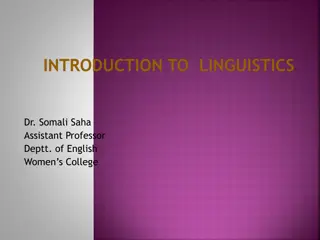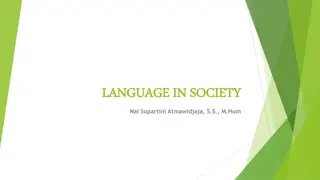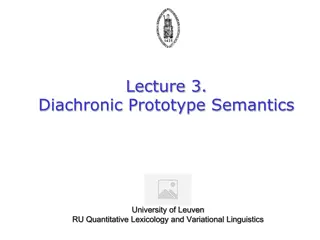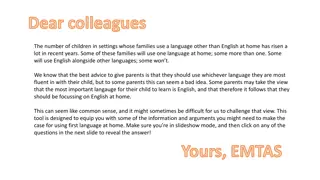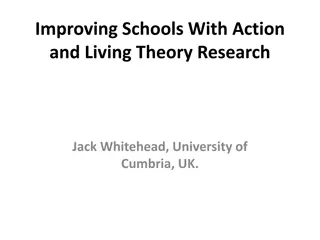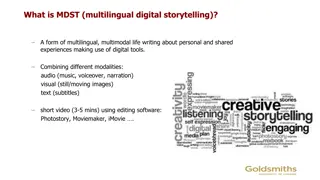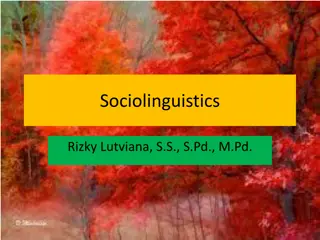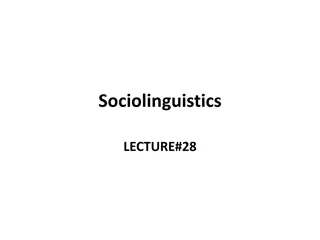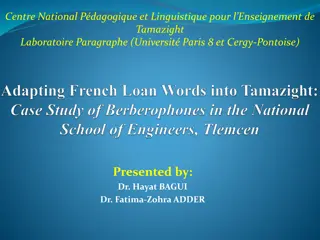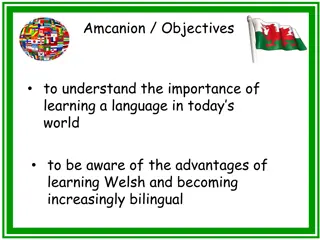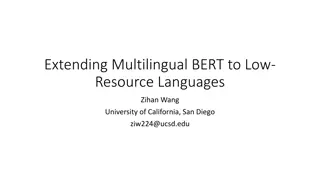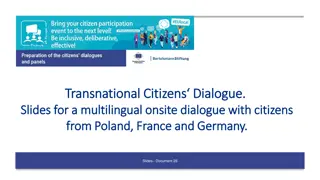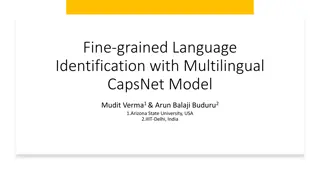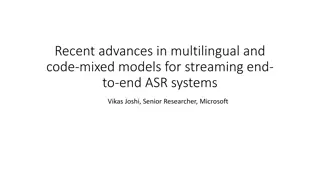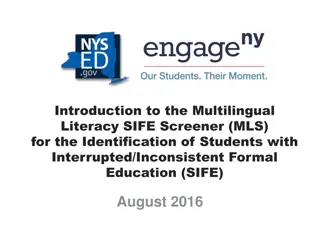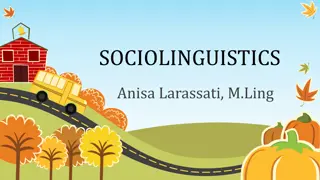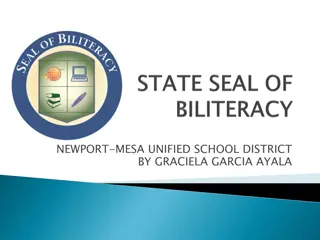The Multilingual Turn in Sociolinguistics: Implications for Educators
Exploring the multilingual context in Vanuatu, this article delves into the historical evolution of language policies and their impact on education. It discusses the diverse language landscape in Vanuatu, the challenges faced by educators, and the shifting paradigms in language instruction over time.
Download Presentation

Please find below an Image/Link to download the presentation.
The content on the website is provided AS IS for your information and personal use only. It may not be sold, licensed, or shared on other websites without obtaining consent from the author.If you encounter any issues during the download, it is possible that the publisher has removed the file from their server.
You are allowed to download the files provided on this website for personal or commercial use, subject to the condition that they are used lawfully. All files are the property of their respective owners.
The content on the website is provided AS IS for your information and personal use only. It may not be sold, licensed, or shared on other websites without obtaining consent from the author.
E N D
Presentation Transcript
The multilingual turn in Sociolinguistics: What use is it to educators? Fiona Willans fiona.willans@usp.ac.fj
Outline Vanuatu a context for multilingual education A quick sketch of the multilingual turn in Sociolinguistics and what this could mean for educators My own experiences trying to work with these new frames of reference, when analysing my data from two school communities in Vanuatu when sharing findings with teachers from my study when talking to policymakers (Ministry of Education, Teachers College, Curriculum Unit) about my research
Vanuatu as a linguistically diverse context: Implications for education Languages: (Population: 240,000) 100+ Austronesian languages Bislama (National variety of the English-based Melanesian Pidgin) English French (former colonial languages)
1906 - 1980 Colonial LPP as competition
1906 - 1980 Colonial LPP as competition 1980 Post-colonial LPP as compromise English- medium French- medium A dual submersion model
1906 - 1980 Colonial LPP as competition 1980 Post-colonial LPP as compromise English- medium French- medium A dual submersion model 2010 National LPP as one attempt at another compromise (since abandoned) K 1 2 3 4 5 6 7 8 9 0 Vernaculars French English (Bislama) 1 A double-transitional model
1906 - 1980 Colonial LPP as competition 1980 Post-colonial LPP as compromise English- medium French- medium A dual submersion model 2010 National LPP as one attempt at another compromise (since abandoned) 2012 The latest ANGLOPHONE STREAM FRANCOPHONE STREAM K 1 2 3 4 5 6 7 8 9 0 Vernaculars Year 1 Vernacular (including Bislama) Year 2 Year 3 French Year 4 Year 5 English medium French medium Year 6 Year 7 English (Bislama) + French as a foreign language + English as a foreign language Year 8 1 Year 9 A double-transitional model Year 10
How languages are conceptualised within these policy debates Each language allotted its own space on the timetable One language at a time Languages compared in terms of their suitability for education Some languages suppressed to make room for others Multiple monolingualisms (Heugh, 2003; Banda, 2009), rather than multilingualism
The multilingual turn in Sociolinguistics Ongoing revision of fundamental ideas about (a) Language(s) (b) Language groups and speakers (c) Multilingualism Rather than working with homogeneity, stability and boundedness as the starting assumptions, mobility, mixing, political dynamics and historical embedding are now central concerns (Blommaert & Rampton (2012, pp.9-10)
What has changed? 1. the nature of linguistic diversity, due to globalization, changing patterns of migration, and different media and technologies of communication AND 2. the realisation that categories such as language , multilingualism , and so on have never adequately captured the complex reality of language use (HOW MUCH OF THIS IS REALLY NEWS TO SPEAKERS OF PACIFIC LANGUAGES?)
The deployment of linguisticfeatures, rather than languages Languages are abstractions, they are sociocultural or ideological constructions which match real-life use of language poorly. This means that sociolinguistics the study of language as a social phenomenon - must work at another level of analysis with real-life language use. We use the level of (linguistic) features as the basis for understanding language use, and we claim that features are socioculturally associated with languages . (J rgensen, et al 2011, p.23)
A more flexible multilingualism, characterised by: a focus on fluidity and flexibility, the prioritisation of language use rather than of abstract, idealised language models, and the understanding that we draw on whatever linguistic (and non-linguistic) resources are available to us, regardless of which language they are traditionally associated with.
Key question Can rethinking multilingualism as the flexible use of multiple linguistic resources help me: a) analyse my data with relevant implications for education policy? b) discuss my findings with teachers from the study? c) discuss my findings with official policymakers?
A brief example of how this rethinking helped me analyse my data Good night (North-East Ambae) Good night (French) F: Bongarea tufala R: Nah mas talem bon nuit nomo nao. French gal! S: Awo, mi jalus long yu yu save Franis. F: Honest. Yu jalus blong smol Franis nomo. Lukaot i no naf! S: Nah be yu save Franis. Yu intres long hem. Yu fit. No but you know French. You re interested in it.
A summary of conclusions from the study The official line: English and French are valued equally, and there is no way that one will be dropped; All other languages (but particularly Bislama) are considered unsuitable for education, even though their utility is often acknowledged in this context Unofficially: Knowing a language does not mean knowing all of a language (minimal displays are sometimes enough); There is space for the resources of multiple languages to be used together, even in the classroom, if the focus can be shifted to learning, rather than language competence; Using multiple linguistic resources in school does not prevent the effective teaching of English/French.
Attempt 1: Showing that multiple linguistic resources can work together in an academic context T: The first style that Hau ofa uses is oral story telling. And oral story telling hem i sem mak nomo olsem yumi wanem yumi kolem kastom stori. S: Dukuni T: Dukuni. Dukuni long lanwis blong yumi. Dukuni. Dukuni tavohi dave dam vano dam togarorongo, tomue morovo serigihi vataha revirevi dam vano dave da maturu rave ram veve na dukuni. Dukuni hi a style hi Hau ofa mo yusum? I sem mak nomo olsem stael we yumi stap yusum long= S: = Stori T: Stori blong yumi. Ale ahm dukuni ngerehi ram tangaloi ram veve ram stori oli stori out loud olsem ale yumi, o yumi olsem ol man we yumi stap long lesen nao ol audiences. Be Hau ofa hem i. Uses. Hem i yusum same particular style. S: Ah audience ngwere tangaloi ram toka ram rorotagi?= T: =Ram rorotagi ale Hau ofa nge mo. Oli kolem oral story telling from se Hau ofa i yusum stael ia olsem oral story telling ia nao. Hem i oral oli olsem talem out loud. Okay stori ia hem i olsem se particular style we Hau ofa i yusum ia? It s just as if hem i stap talemaot stori out loud to= S: =Evriwan T: Yes to one audience olsem
What did the teacher herself say about this extract? This was outside class so it was okay. If I explained in English outside class, it would be odd. She s from my village. If I use too much Bislama or Lanwis in the classroom, they ll become competent in the wrong language a problem in the exams. It s very unusual to use my language, Bislama and English at the same time like this. I normally use one at a time.
(Attempt 2: Discussion group, August 2014, with teachers who had participated in my 2011 research) Showing that L2-only doesn t necessarily require much L2 The blozz plimped haggily to the wembong How little language we need in order to survive in the L2 medium classroom. How much we need in order to succeed.
Phloem cells are living cells T: Phloem cells are? Ss: Living cells T: They are not? Ss: Lignified It seems that students understand. Until we see their notes: Phloem cells are living cells. Phloem has cellulose (not lignified) cell walls. They can provide the answers from their notes, but we don t know whether they really understand.
Who does most of the talking? What happens when the students don t give an answer? T: What can you see in the three pictures? S1: Old people S2: Small children S3: People working T: How do these pictures relate to our topic? (SILENCE) T: What is our topic? Ss: Dependency ratios T: Do these pictures show something about dependency ratios? Ss: Yes T: What do they show us? (SILENCE) T: Which people are dependent on others? Ss: Old people and children T: Who provides for them?
What happens in the exam? Q: What is the function of the part marked on the diagram? A: When you are not agree with that something that you are doing you may move a mouse to it and it may come to empty space again The student understands the concept perfectly. But the student struggles to explain the concept in English and the answer is marked incorrect.
Does this help? Using classroom data helps show that L2 only does not necessarily mean much L2 is actually used (particularly by the students); So it enables teachers to rethink some of the assumptions underlying school rules and teacher training; However, it doesn t get us past the but they should be better at L2 argument.
Attempt 3: Presentation at Vanuatu Ministry of Education, August 2014 (Attendees from the Ministry, the Teachers College and the Curriculum Development Unit) Attempting to tackle each of the deep-rooted L2-only arguments in turn
Feedback from the presentation Individual counter-arguments all accepted, e.g. relief from teacher trainers that it s okay to do what they re doing anyway (advising teachers to use L1 alongside L2) even 100% agreement that Bislama is suitable for education (including from one participant who had argued vehemently against it in an interview) BUT each counter-argument was quickly rebutted by one of the other arguments
Attempt 4: Recognising the complexity and the interconnectedness of the whole, rather than individual arguments Opening up space for multilingual education in Vanuatu: Challenging the web of myths But prioritising English/French over the LEARNING OF CONTENT will not bring any opportunities for individuals or society But international evidence shows that this simply doesn t happen without EXPLICIT FL teaching But outside school, these languages are used in politics, non-formal education, business, etc. etc. Statistics show that ONLY 14% of jobs ask for English and French (20% require English; 0.7% French) Vanuatu data shows low levels of L2 CHANGE is needed Inside school, these languages have enormous instrumental potential to help children UNDERSTAND and PARTICIPATE Classroom data shows that teachers do all the language work: Students have no INCENTIVE to master the LOLT But Bislama is an official language, the language of parliament, etc. Interviews enabled participants to express some complex negative views ABOUT Bislama, IN Bislama! But multilingualism works JUST FINE in non-school learning events What s the difference? English & French bring automatic opportunities (both = best) People seem to want English AND French Clearly more than one language IS okay. The 106 vernaculars & Bislama have no value Any language can be mastered and then used as LOLT 3. We have empirical evidence that schools are far from monolingual it s not a local PROBLEM but a wider institutional REALITY Learning in one language is most logical and efficient Assessment is impractical in multiple languages Pidgins such as Bislama are linguistically inferior 2. 4. And why is Bislama described as unstable, when English and French are described as ALIVE and constantly DEVELOPING? 10 myths closing down space for multilingual education 1. 5. Time spent on vernaculars/Bislama could be better spent on English/French 10. But how much knowledge can students demonstrate in L2? What are tests testing? 6. 9. 7. Classroom 8. But CONTENT and LANGUAGE teaching are totally different management is impossible with multiple languages Corpus planning is impossible in so many languages There are viable alternatives for internal assessment in particular pragmatic solutions that depend on resources Materials are too costly and complex to produce With APPROPRIATE language teaching, English and French can still be learnt to a high standard Even where tests remain monolingual, they can be prepared for multilingually How do we challenge this? But classrooms will not be as chaotic as imagined Many languages are SHARED But these languages are already used to discuss complex topics outside school Corpus planning responds to NEED But there are currently very few books in ANY language! TEACHER TRAINING needs to provide teachers with techniques that will help them stay in control Books that do exist are inadequate for L2 learners the money could be BETTER spent Invert the problem: Can SPEAKERS access sufficient linguistic resources for their PURPOSES? (rather than asking whether a language is sufficiently capable) And profiting from students lack of expertise in the LOLT as a way of retaining teacher control can t be right! Students need to be able to ENGAGE Fiona Willans King s College London (ESRC funded: ES/H016775/1) Evidence from PNG shows that materials CAN
Summary I found that too much rethinking can seem off-putting, but that people can be persuaded to rethink practice if they have the opportunity to judge for themselves whether arguments are validated by their own data; Providing concrete counter-arguments seemed the best way to dislodge stubborn arguments; Keeping the complex whole in focus is important, even while working on just one part of the whole; Evidence of what would work instead is obviously crucial, as well as challenging the status quo; If enough of this rethinking can be done through a sideways approach (government-level, teacher training, in communities ), change might become possible.
Tangkiu tumas Vinaka vakalevu Mahalo All presentation materials are available at www.fionawillans.wordpress.com References from the talk Banda, Felix. (2009). Critical perspectives on language planning and policy in Africa: Accounting for the notion of multilingualism. Stellenbosch Papers in Linguistics PLUS, 38, 1-11. Blommaert, Jan, & Rampton, Ben. (2011). Language and superdiversity: A position paper. Working Papers in Urban Language & Literacies, 70. Heugh, K. (2003). Language policy and democracy in South Africa: The prospects of equality within rights-based policy and planning. (PhD), Stockholm University. J rgensen, N., Karreb k, M., Madsen, L., & M ller, J. (2011). Polylanguaging in superdiversity. Diversities, 13(2).
